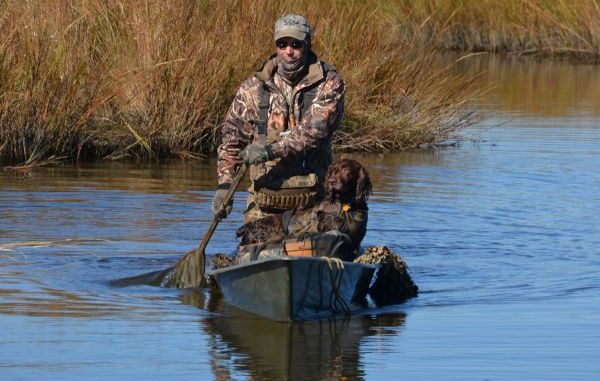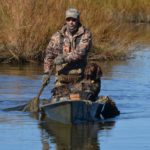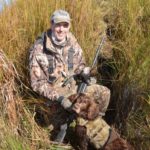
Forget the fancy camo, high-dollar decoys and high-tech surface drive boats. This pair of duck hunters use pirogues and hand-carved wooden dekes to fill their limits in the New Orleans East marshes.
Consider the modern duck hunter.
Armored in the newest pattern of camouflage, he sports two lanyards around his neck, each with four calls on it. His chariot is a specially designed shallow-water hull, powered by not one but two souped-up surface drive engines.
The snarling boat roars through 3 inches of marsh water, throwing a towering brown rooster tail, unerringly guided to its destination by an enhanced GPS mapping system.
His semi-automatic shotgun costs $1,200, all the better to run through those dollar-a-shot nontoxic shells (cheap steel is for amateurs).
A high-dollar retriever that has been to dog college twice is nestled among the decoys.
The decoys — oh yeah, the decoys.
Besides three different styles of electrically powered motion decoys, he has a few dozen hollow plastic dekes, molded and painted so realistically as to fool even the most-discriminating fly-by waterfowl.
Is this Cal Kingsmill?
Not!
Cal Kingsmill is the exact opposite of this hunter in every detail.
Cal Kingsmill hunts over his own hand-carved decoys. And Cal Kingsmill kills ducks — lots of ducks.
Kingsmill and I met his hunting partner, 57-year-old Ray Bellant, and his Boykin spaniel retriever Ridge in the frigid predawn darkness with which duck hunters are so well acquainted.
“Duck hunters have to be a little bit masochistic,” Bellant murmured during the icy ride out the Intracoastal Waterway and down Chef Menteur Pass.
Loaded on the boat were the men’s pirogues and four wooden bushel baskets of Kingsmill’s wooden decoys. The plan was for Kingsmill to set the decoys, while Bellant retrieved some willow and mong (aka baccharis) brush they had stashed earlier to add to the natural marsh grass cover the men would hunt in.
Calling their hunting spots “blinds” was a liberal use of the word. They were short, open-topped barrels partially sunk in the marsh mud, with a board laid across the top of each for a seat.
The brush hauled into the marsh was stabbed in the mud around each blind to break the hunters’ outlines.
Their pirogues were simply pulled into the marsh grass near their blinds, ready for use when needed, and covered with camouflage webbing — low-tech.
“I like to stay with pirogues for two reasons,” Bellant said. “I like to stay small, and they are easier to hide. The other thing is that surface drive boats are tearing up the marsh.
“They don’t want to hear it, but it’s true. If they can’t get somewhere, they just get bigger horsepower.”
Kingsmill’s views are pragmatic.
“If I ever get to where I can’t use a pirogue, I won’t think twice,” he said. “But pirogues are how I was brought up and I’ve never thought of changing.”
The lightening sky revealed decoys that appeared to be sitting on a perfectly reflective mirror.
“We need wind,” Bellant grunted. “There will be a lot of ducks just sitting on (Catherine and Borgne) lakes today.”
“They predicted some wind for today,” Kingsmill replied hopefully.
What wind was predicted was supposed to come from the south-southwest, a bad direction for the hunters. They would have to face the angry glare of the rising sun.
“One thing about Cal’s wooden decoys is that they swim better in the least wind, not like plastic decoys — factory-made decoys,” Bellant said.
Minutes before legal shooting hours, a teal plopped itself down in the decoys. Neither man said a word, and it quickly skittered off.
At exactly legal shooting time, three gray ducks came over to admire Kingsmill’s art.
Two crashed down.
A few birds were moving around, and the hunters tried to work them.
Like everything they did, their calling was low-key. They softly quacked, teal peeped and gray-duck grunted (more about that elsewhere).
They seldom hail-called and never loudly highballed.
At 7 a.m., Bellant walked to his pirogue to retrieve a forgotten item. Kingsmill decided to step out of his blind barrel to relieve his distended bladder.
“Well, I guess a duck will come in now,” he grinned.
As if on cue, a green-winged teal banged over the decoys.
Kingsmill’s hands were occupied, but Bellant took a snap shot and dropped it deep in the tall marsh grass.
As he did all morning, Ridge made a perfect retrieve; the 7-year-old dog had a good nose.
Even without any wind to give it movement, the decoy spread was attractive. Because they were individually carved, each decoy was different, giving the spread a life-like appearance.
Kingsmill had put out gadwalls, teal, wigeons, pintails and spoonbills, but no mallards.
“We used to kill a lot of mallards here,” Kingsmill said by way of explanation. “Maybe it’s gotten too salty here. The mallards don’t come down anymore.”
By 7:35 a.m., they had only bagged one more green-winged teal and a gadwall, and it was blue sky, wall-to-wall.
And still no wind.
“It’s going to pick up,” Kingsmill predicted.
At 7:50 a.m., they took two of three blue-winged teal that volunteered to come in with no calling.
Both men were expert callers. Several times Kingsmill blew two calls at once, a gray duck call in one corner of his mouth and a pintail whistle in the other corner.
At 8:20 a.m., it seemed that even Kingsmill was losing confidence.
“Dang, it’s calm,” he murmured with a mixture of disgust and wonderment.
The pair of hunters huddled together in the tall grass, quietly talking decoys and duck calls.
Amazingly, at 10:15 a.m. a breeze started popping and the decoys began to dance.
Bellant returned to his barrel blind, and in no time they got the birds to finish the hunt.
The take was a nice mixed bag of gray ducks, and blue-winged and green-winged teal.


